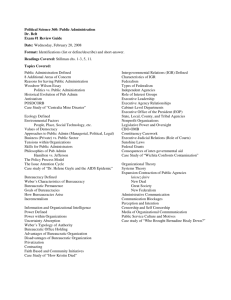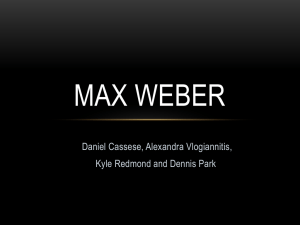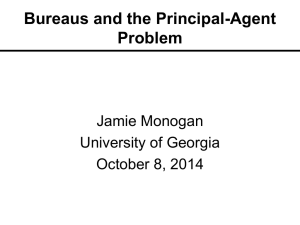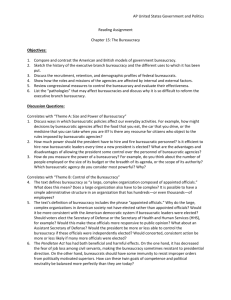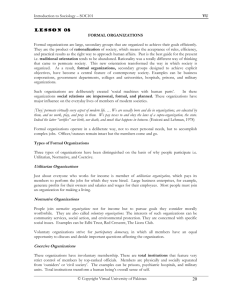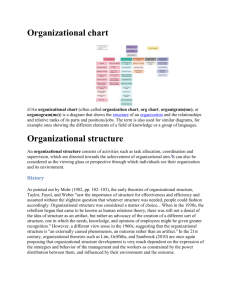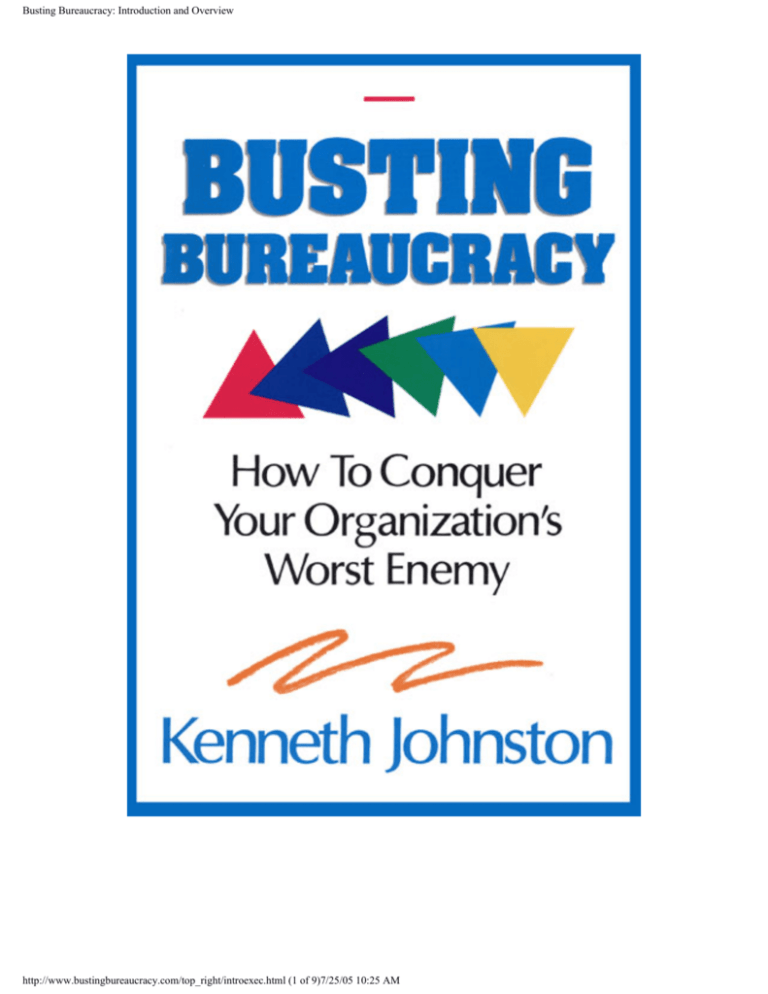
Busting Bureaucracy: Introduction and Overview
http://www.bustingbureaucracy.com/top_right/introexec.html (1 of 9)7/25/05 10:25 AM
Busting Bureaucracy: Introduction and Overview
TO: My Boss
SUBJECT: The book, “Busting Bureaucracy”
I read this book and I think it describes our organization—at least a little. I’d like to get your thoughts.
I read this book and I think it has a lot to offer our organization. If you agree, feel free to pass it on to others.
This book supports our (Quality) (Service) campaign, and reinforces how important it is. What do you
think about getting the whole management team a copy? We could even get one for everyone in the
organization, if you agree. (There’s a section just for managers and one just for front-line people.)
I was so excited about this book that I ordered a bunch to pass around. Please read it and let’s talk.
Signed:
http://www.bustingbureaucracy.com/top_right/introexec.html (2 of 9)7/25/05 10:25 AM
Busting Bureaucracy: Introduction and Overview
Introduction
Preview
This introduction presents, in summary form, some conclusions and assertions that are developed
throughout the book. In addition, you will find some exciting possibilities, along with some
provocative, and even outrageous, statements. One purpose is to stimulate you to want to read the
book. The other is to offer easily found book-bites to critics and talk show hosts.
A summary of conclusions
• The bureaucratic organizing model is the most common organizing model for private and public
sector organizations throughout the world. The bureaucratic model does not produce organizations
that are extraordinary at satisfying customers or achieving "quality" in their products.
• A number of Japanese companies have, almost inadvertently, modified the basic bureaucratic
model, and have been able to competitively dominate many of the world’s unmodified bureaucratic
business organizations.
• Businesses throughout the industrialized world, reacting to increasingly global competition, are
seeking to become "customer focused," or are adopting some form of "Total Quality Management."
In the early stages, both TQM and becoming "customer focused" reduce the negative symptoms of
bureaucracy. Eventually, however, the underlying bureaucracy becomes the biggest barrier to these
organizations achieving their goal. At some point, these organizations will be forced to confront the
fact that they are organized based on the bureaucratic model.
• Monopoly is the major ally of bureaucracy. Bureaucracies can only succeed when protected by
tariffs, patents, copyrights, market positioning, oligopoly, or outright monopoly. In truly
competitive arenas, unmodified bureaucratic organizations seldom earn the customer satisfaction
needed to compete.
http://www.bustingbureaucracy.com/top_right/introexec.html (3 of 9)7/25/05 10:25 AM
Busting Bureaucracy: Introduction and Overview
• Bureaucracy seems to be the organizational form that produces the highest levels of personal
satisfaction for those at the top of an organization. It seems that virtually every organization that is
protected from market forces eventually becomes more and more bureaucratic.
On the other hand, in a free market, less bureaucratic organizations put competitive pressure on
bureaucratic organizations until they are forced to become market driven to survive.
In other words, organizations tend to become bureaucratic when they are allowed to, but will be
market driven when forced to by competition.
• Government agencies represent the worst of all possible combinations. Each agency is given some
form of monopoly. Each agency is organized as a bureaucracy. It should be no surprise that
government agencies come in dead last when consumers are asked to evaluate organizations in
terms of "productivity," "quality" or "service."
The tragic results are evident everywhere. The people in government are blamed for the poor
results, yet they are victims of a poor organizing model. The citizens get poor results for their taxes,
and they blame it on politicians or people in government. Politicians do their best to bring about
meaningful change, and their efforts are defeated by government workers trapped in a system
immobilized by bureaucracy. It is time to recognize the real villain, the bureaucratic organizing
model. Citizens, politicians, appointees and government workers are all victimized by bureaucracy.
Assertions and observations
• The successful Japanese companies are powerful but vulnerable. Even though they have modified
bureaucracy, most Japanese companies are still organized using the basic bureaucratic form. I assert
that those large, bureaucratic organizations can be overtaken by "mission driven" organizations that
are flexible, responsive, innovative, and have "customer friendly" policies, practices and procedures.
• With the possible exception of a few governmental agencies, I believe that the bureaucratic form is
NEVER the best organizing form. In case I’m not being clear enough, let me say this.
I believe there is no legitimate reason for any public or private sector organization that aspires to
quality products or customer-satisfying service to continue using the bureaucratic organizational
form.
• Many Western organizations, in both the private and public sectors, are installing "quality"
programs as part of their search for excellence (as well as a cure for the symptoms of bureaucracy).
Most are using some form of "shadow" organization (steering committees, task forces, action teams,
etc.) to implement "quality" in their organizations. I predict that the organizations’ underlying
bureaucracy will defeat these efforts unless the shadow organizations are organized in a "missiondriven" form (a non-bureaucratic form described in this book). To be clear, having observed many
cases, we have never seen a bureaucratically organized shadow organization cure a bureaucratic
organization of poor quality or service.
http://www.bustingbureaucracy.com/top_right/introexec.html (4 of 9)7/25/05 10:25 AM
Busting Bureaucracy: Introduction and Overview
• The employees of bureaucratic organizations suffer the most. The more bureaucratic the
organization is, the more stress, anxiety, and anger the employees have.
• Organizational health and success in the future may depend more on organizational structure
than on access to capital and market monopolies.
Exciting possibilities
• We have alternatives to entrusting our most difficult national issues to bureaucratic governmental
agencies. We can make it possible for some of our government agencies to become mission driven, (a
non-bureaucratic organizing form described herein). And, we can allow more competition from the
private sector to stimulate governmental de-bureaucratization in critical areas.
• The Eastern bloc nations that are building private enterprises from scratch, and Third World
nations seeking a place in the global economy have the opportunity to bypass bureaucracy as their
organizing model. They can begin as "mission-driven" organizations. If they do that, the successful
ones will be able to catch and pass the rest of the world’s unmodified bureaucratic organizations.
• Mission-driven organizations represent the future and the hope of Third World nations. Bypassing
bureaucracy as their organizing model will allow Third World organizations to start small, with
limited capital, and accumulate capital as they grow profitably through market acceptance, rather
than relying on the extensive capital and market monopolies required for success with the
bureaucracy model.
• I believe that a combination of private enterprise and purposeful de-bureaucratization will make it
possible to overcome the bureaucratic paralysis that immobilizes public education in the United
States. My book, "De-bureaucratize Please!" written for people in government, offers a vision of a
"customer-focused" education system. This vision is so powerful and so compelling that I predict the
bureaucratic educational system will adopt it and bring it to life, or else the citizenry will "privatize"
education, and replace the existing educational system and its bureaucracy.
Provocative and/or outrageous statements
• Max Weber has done as much economic and social damage by idealizing bureaucracy as Marx and
Lenin did by attacking capitalism and promoting communism.
• Bureaucracy and communism are two models for organizing enterprises that sound good on
paper, but produce really rotten results:
For example, the "drug problem" in the United States may have been unintentionally spawned by
two huge bureaucracies, the American Medical Association and the Food and Drug Administration.
Between them, they have dictated that mood management must be controlled by a physician, and
that it is not permissible to manage moods except as a solution to a medical malady. As a result, they
http://www.bustingbureaucracy.com/top_right/introexec.html (5 of 9)7/25/05 10:25 AM
Busting Bureaucracy: Introduction and Overview
have inadvertently created a monopoly in which only criminals may sell mood-management
products, and they have made it impossible for scientists and ethical drug companies to compete by
offering safe, reliable and non-addictive mood-management products that would drive the
criminals, with their expensive, dangerous and addictive drugs, out of business.
• The single greatest cause for the failure of communism was that communism was organized based
on the bureaucratic model, thus creating suffocating and immobilizing bureaucracies.
• Bureaucracy has killed communism. It has socialism in a death grip, and is suffocating and
immobilizing every capitalistic organization that adopts its false promises.
• Unions will change or die. Unions depend on alienation between workers and the organizations in
which they work. To produce quality products or deliver extraordinary customer satisfaction,
workers must become team members in unified, mission-driven organizations that cannot be
divided against themselves. Given the reality of global competition, the only organizations that will
be able to survive with alienated work forces will be those with some form of monopoly.
• Unions may continue to have a role to play in healthy, non-monopolistic organizations, but to play
that role they will have to become aligned with the mission and help to support the mission, rather
than be a divisive influence. The future of the union lies in healing rather than creating worker
alienation. If unions are to have any viable role, union leaders and their organizations need to be
supported by stakeholders so that they create worker harmony that supports the organization’s
mission.
Summary
In this introduction, you’ve found some well-grounded conclusions as well as some outrageous
assertions. I trust your judgment in deciding which is which. If the introduction has served to whet
your appetite for the rest of the book, then it is has served it’s purpose. If it hasn’t, then you’ve saved
several hours. If it’s done neither, then please disregard it.
An executive summary:
the book in a nutshell
Preview
This chapter serves as a summary of the entire book. The purpose is to give you an overview of
what is contained in the book. It describes the goals of the book and serves as a preview of what the
book covers.
http://www.bustingbureaucracy.com/top_right/introexec.html (6 of 9)7/25/05 10:25 AM
Busting Bureaucracy: Introduction and Overview
This book is intended for people who work in bureaucratic organizations. It is designed to be
circulated among managers to stimulate dialog, build commitment and facilitate decisions regarding
possible changes to the organization. It is also designed to be given to people who are currently not
managing so they might participate in the decision to change, or so they will understand any change
effort that the management team decides to undertake.
The goal of the book is to help you learn the following:
1. Your organization is almost certainly organized using much or all of what is called the
"bureaucratic form."
2. Virtually all organizations that use the bureaucratic form seem to suffer the same suffocating and
immobilizing symptoms that people call "bureaucracy."
3. Most employees blame their organization’s "bureaucracy" on senior management. They assume
that management must want it, or it wouldn’t be tolerated.
4. Senior managers don’t want or like "bureaucracy" any more than the rest of the employees. The
detestable effects of bureaucracy victimize everyone, regardless of level. Senior managers haven’t
known what to do to get rid of it. Executives have tried many things to eliminate "bureaucracy," but
the "program-of-the-year" approach generally hasn’t worked, because they have been fighting
symptoms, not the root cause.
5. The root cause of "bureaucracy" is the organizing model, the "bureaucratic form." Yet, the
bureaucratic form is so pervasive that its destructive nature is seldom questioned.
6. If you were starting a new enterprise today, you could avoid "bureaucracy" by using a new
organizing model called the "mission-driven" model.
7. Existing bureaucratic organizations can reduce the amount of "bureaucracy" by changing one or
more of the basic organizing principles, either temporarily or permanently. This book outlines a set
of steps for de-bureaucratizing by changing basic organizing principles:
a. Make an assessment of the present state of the organization to learn how much permission to
change and commitment to change is available from stakeholders and senior management.
b. Depending on the amount of available commitment, choose the optimal goal state: a modest
goal, a moderate goal, or an ambitious goal.
c. The goal state will suggest the strategy for changing the organization. The strategy will range
http://www.bustingbureaucracy.com/top_right/introexec.html (7 of 9)7/25/05 10:25 AM
Busting Bureaucracy: Introduction and Overview
from a minimum effort based mostly on training to a maximum effort based on reorganization and a
new way of managing called "continuous improvement."
d. Continuous improvement is an entirely new way of operating in which the people closest to
the product or customer, working in teams, are empowered to continuously improve the
organization’s quality, service, or both. Continuous improvement requires three things:
i. A "shadow" organization chartered to make the changes necessary in the existing
organization to achieve the desired goal state.
ii. New forms of qualitative customer feedback from internal and external customers to be
used to drive changes in quality, service, or both.
iii. Training for employees enabling them to work in teams, to accept the offered
empowerment, to identify and prioritize root causes of problems, and to find solutions they will use
to continuously improve quality, service, or both.
8. Management people in the existing organization will need to learn and use new ways of
managing. They will need to learn what they have been doing that adds to the "bureaucracy" in the
organization. They will need to learn new ways of doing their jobs that diminish the amount of
bureaucracy within the organization. Most importantly, they will need to provide empowerment for
those who work for them, and protection and coaching to those who accept and act upon the offered
empowerment.
9. People in the organization who currently aren’t managing will play a vital new role in the debureaucratized organization. The labor/management war, if it exists in your organization, must
end. Everyone in the organization will need to act as one unified team, driven by a common mission,
and aligned by a common vision of the new organization. People who today are not formally
managing will be grouped into teams in which the brainpower, skills, talents, and experience of the
individuals will be harnessed to continuously improve the organization’s quality, service, or both.
People who are presently not in managerial positions will be drawn to enroll in the change effort
because their new, expanded role offers less bureaucracy and more opportunity for motivation
through personal growth, achievement, responsibility, recognition and more interesting work.
10. Finally, the book closes with a vision of what your organization might look like, and be like,
when you have achieved your desired goal state. You will discover the rewards that come from
working in an organization of empowered people who are satisfying or even dazzling their
customers, and are doing so with few, if any, of the immobilizing and suffocating effects of
bureaucracy.
http://www.bustingbureaucracy.com/top_right/introexec.html (8 of 9)7/25/05 10:25 AM
Busting Bureaucracy: Introduction and Overview
Buy This Book in Hard Cover
Buy This Book as a PDF Download
home | order | contact us | webmaster/support
© Visionary Publications, Inc. All Rights Reserved
http://www.bustingbureaucracy.com/top_right/introexec.html (9 of 9)7/25/05 10:25 AM


